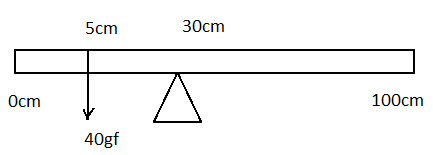
A uniform meter scale is in equilibrium position. Calculate the mass of the rule.

Answer
217.5k+ views
Hint: For solving this question we have to assume that the mass of the ruler be M grams. And the centre of mass of the ruler is at its centre. Therefore, the centre of mass of the ruler is $20cm$ which is away from the hinge. And it is given that the ruler is in equilibrium position. Now, balancing the torques due to mass of the rod which is suspended from the ruler. Knowing all these things we can calculate the mass of the ruler.
Complete step by step solution:
Suppose that the weight of the scale is $m$
And the meter scale is pivoted at $30cm$
And the torques are $40gf$ due to clockwise momentum.
Now,
Let ${T_1} = Mass \times Acceleration$ due to gravity
Now, distance of this weight from pivoted $ = \left( {30 - 5} \right)cm$
Which is $ = 25cm$
So, ${T_1} = 40 \times 25gfcm$
$ \Rightarrow 1000gfcm$
So, now the weight of the scale acts on its centre of mass which is situated at the mid points which is $50cm$
Now, we have to calculate the distance of centre of mass of the scale which is,
$ \Rightarrow 50 - 30$
$ \Rightarrow 20cm$
Now, again calculate for ${T_2}$
Which is weight of rod $ \times $ Distance of the weight pivoted
That is $ \Rightarrow m \times 20$
Now, the sum of clockwise momentum $ = $Sum of anticlockwise momentum.
So, ${T_1} = {T_2}$
Now, substituting the value
$\Rightarrow m = \dfrac{{1000}}{{20}}$
$\Rightarrow m = 50gf$
Hence, the mass of the ruler is $50gf$.
Note: For solving this question we have to remember that the weight of scale and the metre scale is pivoted. A uniform metre scale is kept in equilibrium and a mass is suspended. We have to balance the torque due to the mass of the rod. By using the formula of torque, we can find the mass of the ruler. So, these are some important things which we have to keep in mind while we solve this question to get the correct answer.
Complete step by step solution:
Suppose that the weight of the scale is $m$
And the meter scale is pivoted at $30cm$
And the torques are $40gf$ due to clockwise momentum.
Now,
Let ${T_1} = Mass \times Acceleration$ due to gravity
Now, distance of this weight from pivoted $ = \left( {30 - 5} \right)cm$
Which is $ = 25cm$
So, ${T_1} = 40 \times 25gfcm$
$ \Rightarrow 1000gfcm$
So, now the weight of the scale acts on its centre of mass which is situated at the mid points which is $50cm$
Now, we have to calculate the distance of centre of mass of the scale which is,
$ \Rightarrow 50 - 30$
$ \Rightarrow 20cm$
Now, again calculate for ${T_2}$
Which is weight of rod $ \times $ Distance of the weight pivoted
That is $ \Rightarrow m \times 20$
Now, the sum of clockwise momentum $ = $Sum of anticlockwise momentum.
So, ${T_1} = {T_2}$
Now, substituting the value
$\Rightarrow m = \dfrac{{1000}}{{20}}$
$\Rightarrow m = 50gf$
Hence, the mass of the ruler is $50gf$.
Note: For solving this question we have to remember that the weight of scale and the metre scale is pivoted. A uniform metre scale is kept in equilibrium and a mass is suspended. We have to balance the torque due to the mass of the rod. By using the formula of torque, we can find the mass of the ruler. So, these are some important things which we have to keep in mind while we solve this question to get the correct answer.
Recently Updated Pages
Addition of Three Vectors: Methods & Examples

Addition of Vectors: Simple Guide for Students

Algebra Made Easy: Step-by-Step Guide for Students

Relations and Functions: Complete Guide for Students

Analytical Method of Vector Addition Explained Simply

Arithmetic, Geometric & Harmonic Progressions Explained

Trending doubts
JEE Main 2026: Application Form Open, Exam Dates, Syllabus, Eligibility & Question Papers

Derivation of Equation of Trajectory Explained for Students

Hybridisation in Chemistry – Concept, Types & Applications

Understanding the Angle of Deviation in a Prism

Understanding Collisions: Types and Examples for Students

How to Convert a Galvanometer into an Ammeter or Voltmeter

Other Pages
JEE Advanced Marks vs Ranks 2025: Understanding Category-wise Qualifying Marks and Previous Year Cut-offs

Units And Measurements Class 11 Physics Chapter 1 CBSE Notes - 2025-26

NCERT Solutions For Class 11 Physics Chapter 8 Mechanical Properties Of Solids

Motion in a Straight Line Class 11 Physics Chapter 2 CBSE Notes - 2025-26

NCERT Solutions for Class 11 Physics Chapter 7 Gravitation 2025-26

Understanding Atomic Structure for Beginners




